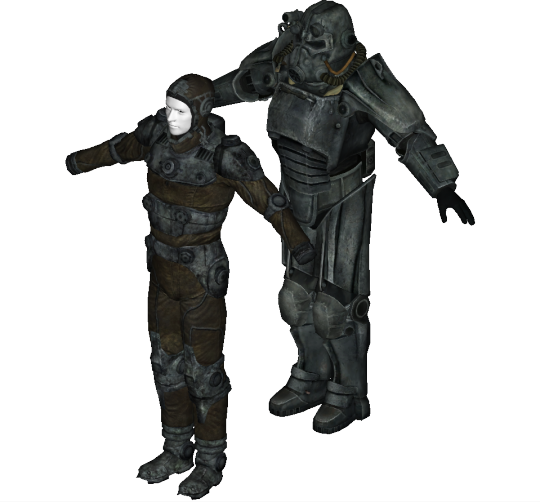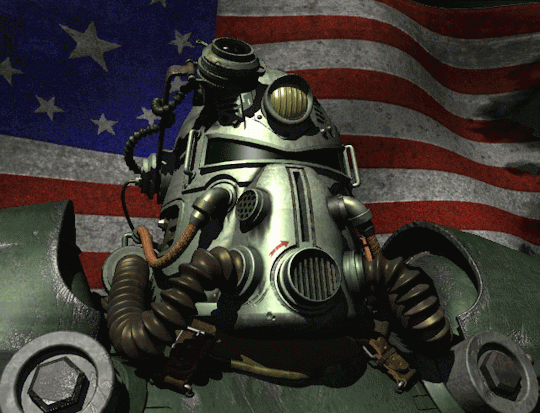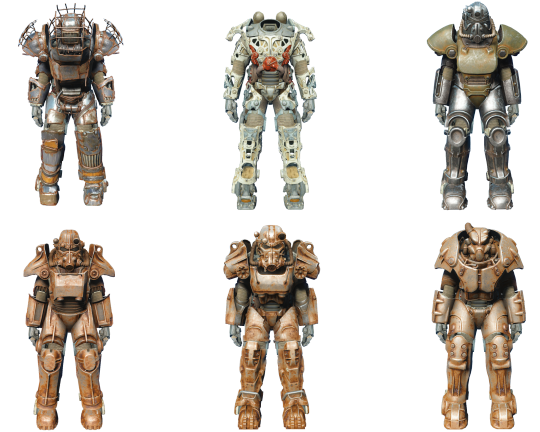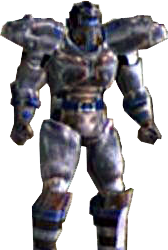This blog catalogues my adventures with original Fallout content. #vanburen is for examining design document content. #exodus is for RPG rules and content. #OC and #fannon are for my personal takes on the games lore. The Primary focus is bridging the gap between the different takes on in universe technologies and lore depicted in the different era's of Black Isle Studio's Fallout Franchise. This also includes excerpts from my Fallout Van Buren Exodus Campaign. I'll be sharing any custom rules I create for the setting so you too can run your own Fallout D20 without the need to bridge the rule gap all on your own.
Don't wanna be here? Send us removal request.
Text
An Overview on Powered Armor
FOREWORD: This post is a collection of my personal thoughts and beliefs. It is an attempt to bridge some gaps and create a more concrete list of technological variants and model details between in lore examples of powered armor. As such this post is primarily #Fannon. Future smaller posts that link back to this one will expand on lore variants, we will be covering the technology and less so the events that led to their developments. This post will also touch on potentially non canonical entries to the series as well such as #vanburen and #tactics

Fallout 1 Power Armor Concept Art
Lets begin with the earliest example of functioning and mass produced Powered Armor and my personal favorite the T-45 series of armor. As touched upon by J-sawyer, the early concept for T-45 was a power armor that ran on small energy cells. This feature doesn’t return when T-45D is first encountered in Bethesda’s Fallout 3 and was only meant to be a small detail in Van Buren. My interpretation is that early models of T-45, possibly A through C had this issue. T-45D would have been the first set of Powered Armor to run on its very own Microfusion Generator and could operate entirely without the need to constantly apply new batteries. The T-45 series was victim to another design flaw, one that carried over to the T-45D as well. The need to wear a bodysuit underneath the power armor. This lower layer is the gambeson to the power armor’s full plate. While being armor in and of itself, it's also the integral lower platform that the entire suit is built upon. Without the recon armor, you would have a pile of armor and servos

This leads into the first step of bridging the gaps in the lore. The previously described sets of T-45 fall into the visual spectrum of Fallout 3. The armor is ultimately hardly larger than your average person. Mostly form fitting and not too outlandish. This recon suit system is also how I believe early sets of T-51 were designed. This fits into their depiction in Fallout 3 and New Vegas. I however Don’t think this is how ALL suits of T-45 and T-51 were designed. Recon armor is a platform that power armor was designed around, but isn’t directly linked too. T-45 is ultimately a set of components. The parts and pieces could be assembled onto recon armor to make the familiar smaller silhouette of Fallout 3’s power armor. This however isn’t the only power armor platform. Enter the Power Armor Frame. The Frame wasn’t designed until after T-45 had seen its initial testing and production. T-51 had even seen deployment in China and Alaska before the frame entered production. After the frame was developed it redefined what power armor was. It wasn’t just the next step in combat armor development, it was a whole new way to wage war. The hard Frame allowed for the mounting of life support systems, water and waste recycling and oxygen supplies. I believe this is the kind of power armor we see in Fallout 1 and 2. These examples of power armor can be seen in the games graphics to greatly increase the size and scale of the wearer. This power armor was as advanced and expensive as pre war efforts came. Requiring no training the armor could be worn like a glove. Perfectly mimicking and the movements of the wearer while augmenting their strength and providing extreme protection.

Enclave Advanced Power armor likely uses this frame system as well due to its sharing in the T-51b’s life support systems. It’s worth noting that the advanced power armor seen in New Vegas appears to be soft framed due to its small size and need of power armor training This could be explained by the enclave simply making their armor on whatever frame type they had lying around.

The heavy cost of Fallout 2’s events on the enclave would greatly cost them in their technological development and supplies. Needing new power armor quickly they would have to resort to cheaper methods of production and created Fallout 3’s Enclave Power Armor. Which is comparable to pre-frame armor systems like T-45d. Eventually they would create Hellfire Power Armor, the pinnacle of pre-frame style power armor in an attempt to gain an edge over the advancing Lyon’s Brotherhood. It is worth mentioning that we get to see Modular Frame variants of the fallout 3 Enclave armors in Fallout 4 as dlc. As Bethesda has said before, Creation Club Content should be treated as non canon. If you would like to include these in your canon you can consider these to be limited production variants fitted to the Modular Frame type we’ll cover in the next paragraph.

As time marched on it was obvious that the full production T-51b fitted to hard frames would not be economical to continue to mass produce. In order to greatly reduce the cost of individual suits of power armor the frame was reworked. The Microfusion Reactor was dropped and a slot to accept civilian market fusion cores was added. All of the life support additions were also removed. Sets of T-45 and T-51 would be created to fit onto this new modular system. Some sets of T-45 would see improvement into new sets of T-60 which were produced entirely for the Modular Frame. The modular system accepted cheaper sets of armor designed to be easily removed and replaced for maintenance. While the fusion cores greatly limited the operational time of the power armor, it made them perfect for safer state-side deployments where maintenance and spare parts would be readily available. These Modular Frames were cheap enough to produce that several sets were created and sold as promotional material to different corporations. The armor mounted to these frames seem to be break away, As enough damage would ultimately break earlier suits of soft and hard framed power armor, resulting in the need for full suit maintenance, Damage to the armor of Modular frame system suits would simply require new armor be bolted to the frame while the old armor was repaired. This frame type would be the test bed for X-01 armor. The Pre-war Predecessor of Advanced Power Armor. Advanced Power armor would ultimately be fixed to a hard frame featuring life support systems and its own self contained power source.

The Elephants in the room. Quick and honorable mention to midwest power armor and vault tec power armor. I believe these two sets to be based on the early soft frame designs. The Midwest Brotherhood likely made their own armor templates to fit over damaged and worn sets of T-45D and early T-51, it is ultimately not its own set of power armor, but a jury rigged set of repairs set under a fresh pressed set of armor plating.

Vault Tec’s power armor is likely also a set of soft frame power armor but built from scratch due to the companies inability to acquire or manufacture their own sets of T-51.

A note on Fallout 76. The power armor chassis is likely just a modular power armor frame with some release mechanisms to get it fold or compress into a more easily transportable state.

Well that’s all I have for you. This is an overview of how I explain the different depictions of power armor throughout the games. More in depth details and RPG pen and paper details will come in at a later date. Thanks for reading.
7 notes
·
View notes